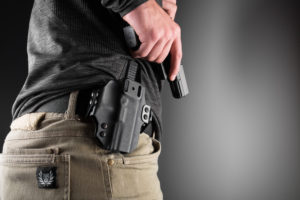The new TCI™ Liberator® IV, V, and HP headsets meet law enforcement and special operations forces’ current demands and requirements.
Liberator® headsets’ key features include electronic hearing protection to provide full-spectrum environmental sound and incoming radio communication simultaneously. The multimode dual processor design includes active noise cancelation (ANC) to add additional electronic protection against steady-state noise. A combined mode pairs the two processors to provide the end-user complete electronic protection against both impulse and steady-state noise. The Liberator® series tactical headsets have been deployed by the Department of Defense, law enforcement agencies, and security teams during missions in Afghanistan, Iraq, and worldwide. Thousands of systems are currently in service today, and thousands more will be deployed locally and around the world in the future. All Liberator® headset systems are designed, engineered, and manufactured in Ontario, California.
Liberator® tactical headsets exceed military durability standards with earcups made from durable Safari 7 TM glass polymer, which offers scratch-resistant protection and exceeds the high and low-temperature thresholds of current headset earcups. The Safari 7 TM glass polymer is the same type of material that Safariland® uses for its 7TS holsters systems. The headset features multimode digital hearing protection for all sound environments, high-battery life from a choice of two battery types, low-profile earcups, state-of-the-art digital sound processing for optimal reproduction of environmental sounds, and leading radio frequency (RF) and time delay multiaccess (TDMA) shielding for using advanced digital waveforms such as ANW2. TCI™ utilizes an exclusive Advanced Digital Threat Compression Technology (ADCTC) that compresses hazardous sound levels while providing the user with continuous situational awareness, communications, and the best replication of ambient sound. The TCI™ Advanced Digital Situational Awareness Enhancement technology (ADSAE) provides the user with precise sound localization and proximity of ambient sound to maximize the user’s effectiveness and safety. The headsets also feature an active noise cancelation (ANC) mode to provide an additional 5-8dBa reduction above the steady-state 25dBa (25NRR) offered passively by the earcups themselves. The third mode of operation combines ADCTC and ANC modes to provide electronic protection against steady-state noise and impulse noise.
Additionally, in this mode, the headset features a speech isolation mode that isolates close proximity human speech out of the background noise, processes it, and replicates it inside the earcup allowing end-users to communicate face-to-face without the need for an intercom. The modern electronics on this headset are firmware updatable using near field communications (NFC) protocols. These progressive attributes and an array of others enable Liberator® headsets to be ideal for tactical missions. Liberator® headsets provide the performance necessary to support operator concentration, safety, mission completion and reduce user fatigue.
The Liberator® IV and V Tactical Headsets provide exceptional communications and electronic hearing protection during typical and critical situations. The ability to maintain peripheral hearing and amplify potential danger signs and audio clues from the environment are unique features of Liberator® systems and necessary for tactical missions. The electronic hearing protection of Liberator® V systems is the most advanced available. Less progressive systems “clip” or “cut-off” ambient sounds while the hearing protection is activated, impeding situational awareness for the user and often negatively affects incoming communications. On the other hand, Liberator® systems compress and reduce hazardous sound to safe levels inside the headset without muting ambient sounds or incoming radio communication audio. The TCI™ ADSAE technology provides 360 degrees of ambient sound reproduction. This technology is the most accurate method of environmental sound replication, threat identification, and threat localization. It uses dual external microphones that continually process ambient sounds and instantaneously compress impulse noise. With up to 29 dBa of attenuation, the headset protects the user from exposure to harmful static-state and impulse sounds by compressing dangerous sound levels to approximately 82 dBa. The headsets feature a fixed behind-the-head comfort fit, and the headset suspension provides a comfortable fit with any helmet type. The rigid band is situated low enough to not conflict with different nape pads or ratchet-style helmet suspension systems. The band is also adjustable to allow for the best fit possible.
Liberator® IV Tactical Headsets come with compact single-channel tactical Push-to-Talk (PTT), with a quick disconnect radio interface cable. These radio interface cables are the same cables used on the TCI™ Liberator® 3 & 5 dual comm systems. The system includes a factory mutually approved radio interface connection, assuring the connection precisely meets radio model specifications. This model provides radio interface cables for military radios using a U329 connection and for the Motorola® XTS® 5000/PRC153. The switch is protected inside the PTT housing and is easily accessible in all conditions and wearing gloves. The raised PTT enclosure protects the switch from accidental activation. This PTT is ambidextrous, includes a 17″ coiled radio cable, and requires no end-user modification. This Liberator® V tactical headset comes with a compact dual tactical PTT and a compact single-channel PTT. Both PTT devices utilize the same common quick disconnect cables, including a factory mutually approved radio interface connection, assuring the connection precisely meets radio model specifications. The dual communications PTT is wired TEMPEST compliant and includes features to prevent accidental transmission of potential classified traffic over an unclassified radio net. The enclosure and custom aerospace aluminum switches are IP68 rated and have a cycle count of 1 million activations. The switches feature a raised tactile indicator for high and low bands and are easily distinguished in all conditions and wearing gloves. The single communications PTT is a modernized U94 form that is waterproof and features an ambidextrous MOLLE clip. This package allows end-users to conduct single-channel communications without the hassle of a deactivated PTT switch or unused open connections.
A zipped padded storage bag is also a standard feature for Liberator® systems.
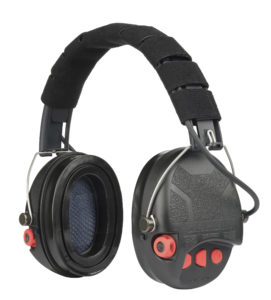
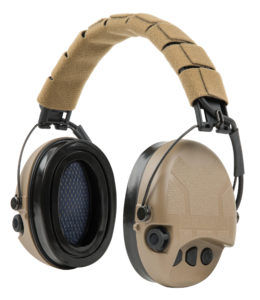

Liberator® HP
See Liberator® HP Products Here
Industry and Governmental Standards: Liberator® HP Headsets are compliant and/or have been independently tested and certified to the following standards.
- ANSI S3.19-1974
- EN352-3
- CSA Z94.2
- IP68
- MIL-STD 810F&G
o Test Method 501.5
o Test Method 502.5
o Test Method 505.4
o Test Method 508.6
o Test Method 509.5
o Test Method 510.5 (Dust & Sand)
o Test Method 512.5
o Test Method 516.6
- MIL-STD 461E
- TDMA Shielding IOW IEC 61000 Specifications:
- Liberator® HP Headset:
- Designed as a circumoral (earcup) system with proprietary dual advanced digital sound processing, universal suspension kit, two black earcups, two ambient sound, and two audio speakers inside each earcup. Each unit includes a pair of removable and replaceable ear seals. The headset is multimode with each mode selectable by the user based on the environment:
- Mode 1 – Automatically replicates ambient sounds in the environment, much like natural hearing, so the user is always aware of their surroundings and compresses impulse noise above 82dBa while not effecting sound localization
- Mode 2 – Provides active noise cancelation for high steady-state noise. This mode electronically adds 5-9dBa of attenuation above the natural attenuation of the earcup itself.
- Mode 3- Combines the two modes providing the end-user with electronic hearing protection for both steady-state and impulse noise. This mode also includes the speech isolation feature.
o Separate communication speakers inside of each earcup deliver communication audio without delay or compromise. Radio audio is split with each source using one earcup. The Liberator® HP is upgradable to become a communications headset.
o All critical electronics and components are environmentally sealed to meet/exceed MIL-STD 810 F&G, including two levels of environmental sealing on electronics inside the earcups.
o The hearing protection system specifications exceed MIL-STD 461E regarding radio frequency-related interference over EMI sweep (50 V/M for frequencies between 1 MHz and 1 GHz) in compliance with MILSTD-461E for EMI/EMC/EMP. The headset printed circuit board has been TDMA shield IAW industry-standard IEC 61000
o The system is free of any shiny or reflective colors or surfaces.
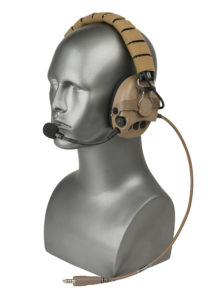

Liberator® IV
See Liberator® IV Products Here
Industry and Governmental Standards: Liberator® IV Headsets are compliant and/or have been independently tested and certified to the following standards.
- ANSI S3.19-1974
- EN352-3
- CSA Z94.2
- IP68
- MIL-STD 810F&G
o Test Method 501.5
o Test Method 502.5
o Test Method 505.4
o Test Method 508.6
o Test Method 509.5
o Test Method 510.5 (Dust & Sand)
o Test Method 511.5
o Test Method 512.5
o Test Method 516.6
- MIL-STD 461E
- TDMA Shielding IOW IEC 61000 Specifications:
- Liberator® IV Headset: o Designed as a circumoral (earcup) system with proprietary dual advanced digital sound processing, universal suspension kit, two Tan 499 earcups, a steel mounting fixture for a flexible communication boom microphone, two ambient sound and two audio speakers inside of each earcup. Each unit includes a pair of removable and replaceable ear seals. The headset is multimode with each mode selectable by the user based on the environment:
▪ Mode 1 – Automatically replicates ambient sounds in the environment, much like natural hearing, so the user is always aware of their surroundings and compresses impulse noise above 82dBa while not effecting sound localization
▪ Mode 2 – Provides active noise cancelation for high steady-state noise. This mode electronically adds 5-9dBa of attenuation above the natural attenuation of the earcup itself.
▪ Mode 3- Combines the two modes providing the end-user with electronic hearing protection for both steady-state and impulse noise. This mode also includes the speech isolation feature.
o Separate communication speakers inside of each earcup deliver communication audio without delay or compromise. Radio audio is split with each source using one earcup. A flexible boom microphone sends voice messages that are transmitted by the tactical radio.
o All critical electronics and components are environmentally sealed to meet/exceed MIL-STD 810 F&G, including two levels of environmental sealing on electronics inside the earcups.
o The hearing protection system specifications exceed MIL-STD 461E regarding radio frequency-related interference over EMI sweep (50 V/M for frequencies between 1 MHz and 1 GHz) in compliance with MILSTD-461E for EMI/EMC/EMP. The headset printed circuit board has been TDMA shield IAW industry-standard IEC 61000
o The system is free of any shiny or reflective colors or surfaces.


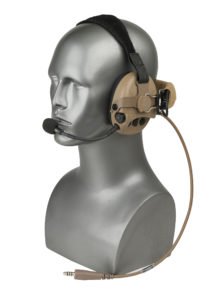

Liberator® V
See Liberator® V Products Here
Industry and Governmental Standards: Liberator® V Headsets are compliant and/or have been independently tested and certified to the following standards.
- ANSI S3.19-1974
- EN352-3
- CSA Z94.2
- IP68 • MIL-STD 810G
o Test Method 501.5
o Test Method 502.5
o Test Method 505.4
o Test Method 508.6
o Test Method 509.5
o Test Method 510.5 (Dust & Sand)
o Test Method 511.5
o Test Method 512.5
o Test Method 516.6
- MIL-STD 461E
o Built to Meet Methodologies:
▪ RE102 – Negative EMI ▪ RS103 – Subjected to frequency sweep and direct RF contact
- TDMA Shielding IOW IEC 61000 Specifications:
- Liberator® V Headset: o Designed as a circumoral (earcup) system with proprietary dual advanced digital sound processing, universal suspension kit, two Tan 499 earcups, a steel mounting fixture for a flexible communication boom microphone, two ambient sound, and two audio speakers inside of each earcup. Each unit includes a pair of removable and replaceable ear seals. The headset is multimode with each mode selectable by the user based on the environment:
▪ Mode 1 – Automatically replicates ambient sounds in the environment, much like natural hearing, so the user is always aware of their surroundings and compresses impulse noise above 82dBa while not effecting sound localization
▪ Mode 2 – Provides active noise cancelation for high steady-state noise. This mode electronically adds 5-9dBa of attenuation above the natural attenuation of the earcup itself.
▪ Mode 3- Combines the two modes providing the end-user with electronic hearing protection for both steady-state and impulse noise. This mode also includes the speech isolation feature.
- Separate communication speakers inside of each earcup deliver communication audio without delay or compromise. Radio audio is split with each source using one earcup. A flexible boom microphone sends voice messages to be transmitted by the tactical radio.
o All critical electronics and components are environmentally sealed to meet/exceed MIL-STD 810 F&G, including two levels of environmental sealing on electronics inside the earcups.
o The hearing protection system specifications exceed MIL-STD 461E regarding radio frequency-related interference over EMI sweep (50 V/M for frequencies between 1 MHz and 1 GHz) in compliance with MILSTD-461E for EMI/EMC/EMP. The headset printed circuit board has been TDMA shield IAW industry-standard IEC 61000
o The system is free of any shiny or reflective colors or surfaces.
- Earcup Material: o Safari 7TM scratch-resistant glass polymer, melt temperature 550o.
- Hearing Protection Certifications: o Noise Reduction Rating (NRR) is third-party tested in accordance with ANSI S3.19-1974, EN352, and meets CSA Class B CSA (Z94.2). The passive NRR is rated at 25.
- Battery Consumption: o Liberator® V headset provides up to 400 hours of operation in mode 1, 200 hours in mode 2, and 100 hours in mode 3.
o The headset is equipped with a dual fuel battery compartment and can use two AAA / LR6 type batteries or 1 CR123 battery. (Each headset system includes two quality AAA batteries and 1 CR123)
o Batteries are enclosed in a watertight battery compartment accessible from the back of the right earcup. The battery cap has an integrated O-ring to provide a complete seal against water and dust egress. The battery cap is integrated into the battery compartment via a hinge attachment.
o The system will provide two beep warning tones every 20 minutes once the battery life has depleted to approximately 40 hours remaining.
o The system provides an audio shut-off feature if the headset is left stationary for four hours or more.
- Controls: Controls on/off feature as well as sound amplification system and mode selection.
o Three buttons on a recessed section of the lower portion allow the user to turn the headsets on or off, adjust ambient sound amplification, and cycle through the headset modes. The headset system can amplify low-level sounds by up to five times normal hearing when the headset is in stealth mode.
o Volume Memory Feature: Retains the headset’s last volume setting when the headset is turned back on.
o There are 8 volume settings at 4dBa intervals
o Volume buttons can be pressed simultaneously to cycle through the three modes of operation. The end-user can select compression/localization, active noise cancelation, and combined mode depending on sound environment and mission need.
- Stealth Audio Mode: Amplifies low-level sound by up to 500% of normal-hearing but does not amplify any sound above approximately 85 dBa regardless of the audio mode.
o Stealth audio mode is activated by pressing the “+” button on the left earcup four times consecutively within ten seconds.
- Suspension Type: o Modular Quick Disconnect System
▪ Kit includes Over the Head, Behind the Head, and Ops-Core rail mount suspension options
▪ All metal quick disconnect attachment system
▪ The traditional suspension features a fixed scalloped polymer suspension strap with metal band reinforcement.
▪ Includes simple Velcro head strap wrap for securing cable and nylon mesh suspension strap for over the head
▪ Headbands designed thin for maximum comfort during prolonged wear and use with ACH. Built for the 90th percentile and IOW US Army ACH fitting guidelines.
▪ Four adjustment positions per earcup side.
▪ Gimbal style adjustable rail mounts
- Microphone: Provides intelligible radio transmissions.
o Type: Noise Canceling, Waterproof, Dynamic o Supplied with Waterproof Windscreen o Talk side of microphone boom marked “TALK” to ensure optimal orientation with user’s mouth.
o Impedance: 150 Ω
o Frequency Response: 1000 Hz
o Gooseneck Diameter: 5.1 MM
o Mounting/Assembly: Steel mounting fixture with stainless steel threaded shaft through earcup and Nylock nut and sealant affixed to the threaded shaft from the inside of the earcup.
o Submersible rating to 20 meters for five minutes
- Speakers: Two Audio Speakers in Each Earcup
o Communication Speakers: One communication speaker is mounted on a circuit board inside of each earcup. Speakers are impedance matched for the user’s radio model.
o Output: 90 dBa (max) o Impedance: 600 ohms o Frequency Response: 300 Hz to 3.4 kHz (tuned for voice frequency range)
o Ambient Sound Speakers: One ambient sound speaker is mounted on a circuit board inside each earcup. o Impedance: 32 ohms for ambient audio speakers.
o Output: 90 dBa (max) o Frequency Response: 300 Hz to 6 KHz
- Headset Weight: o Approx. 300 grams (w CR123)
- Earcup Dimensions: o Approx. 107mm x 98 mm x 42mm (H x W x D) (depth measurement includes headset attachment nexus) o Max. thickness of earcup approx. 28 mm
o Min. thickness of earcup approx. 12 mm • Headset Environmental Standards: o Independently Tested and Certified to MIL-STD 810 F, G
- Headset Operating Temperature: o -55 C to +85 C
- Headset Immersion Rating: o 1 Meter, 15 mins.
- Headset Cable Length: o Approx. 150 MM (including plug)
- Cable Thickness: o Approx. 5.1 MM
- Headset Connector: o Over-molded onto Polyurethane cable jacket for high axial strength, reliability, and durability. o Advanced Military Connector high-density type
- Press-to-Talk Units (PTT): Designed to be large enough to be used during tactical situations and gloved hands but not so large to interfere with movement or usage of other equipment. The Dual Comm PTT provides the user with an easy, intuitive, and effective means of connecting and utilizing two tactical communications channels. The PTTs are environmentally sealed to ensure reliability in harsh and demanding situations. The PTT features an ambidextrous design, heavy-duty clothing clip (Molle/PALS compatible). The Dual PTT is also electronically designed to prevent audio bleed-through between radio pathways. The user can conduct operations with mixed cryptographic settings on his/her radios.
- PTT Enclosure Type: o Box, ambidextrous & Modernized U94 o Available in Flat Dark Earth o Injection-molded composition resistant to abrasions, chipping, or cracking, including an internal O-ring seal.
o The PTT’s side surface has recessed areas for switches to protect accidental keying during movement yet allows easy access to the PTT button with a gloved hand.
o Advanced Multipin Military connectors, waterproof panel mount • Switch Type: o Button type, Custom Aerospace Aluminum, IP68 rated, 1 Million Cycle count. o Features tactile indicators on each button
- Size: o Approx. 32 MM x 32 MM x 28 MM (H x W x D) Dual Comm
o Approx 33 MM x 29MM, 26 MM (H x W x D) Single Comm
- Weight:
o Approx. 200 grams (In typical dual handheld radio configuration)
- Operating Cycles: o 1 Million
- Ratings: o MIL-STD 810 G o MIL-STD 461E o IP-68
- Operating Temperature: o -55 C to +85 C
- Country of Origin: o USA

